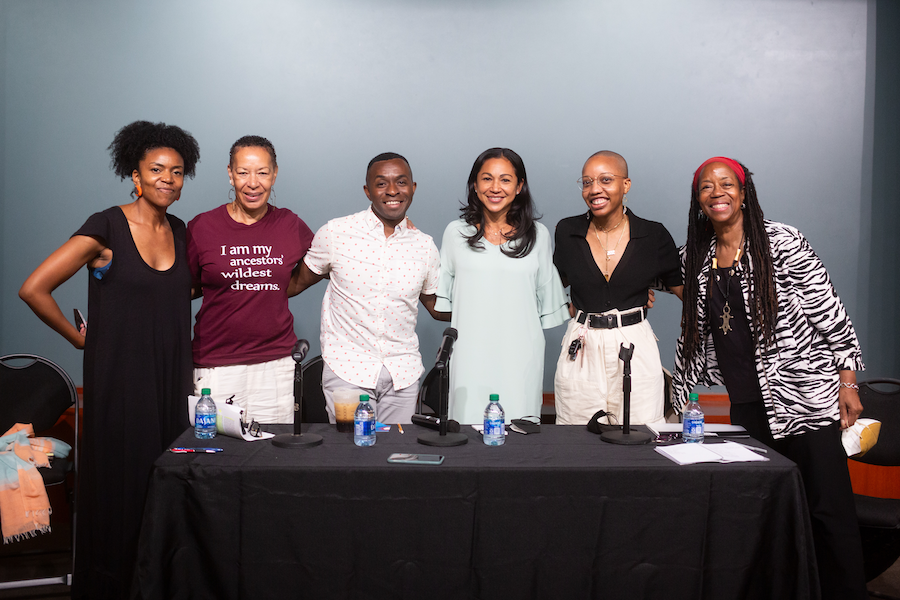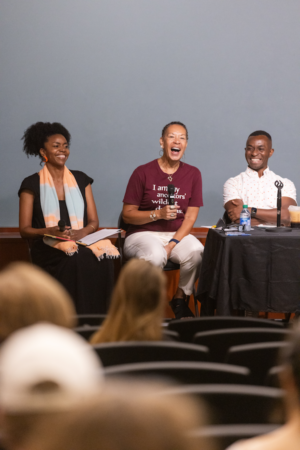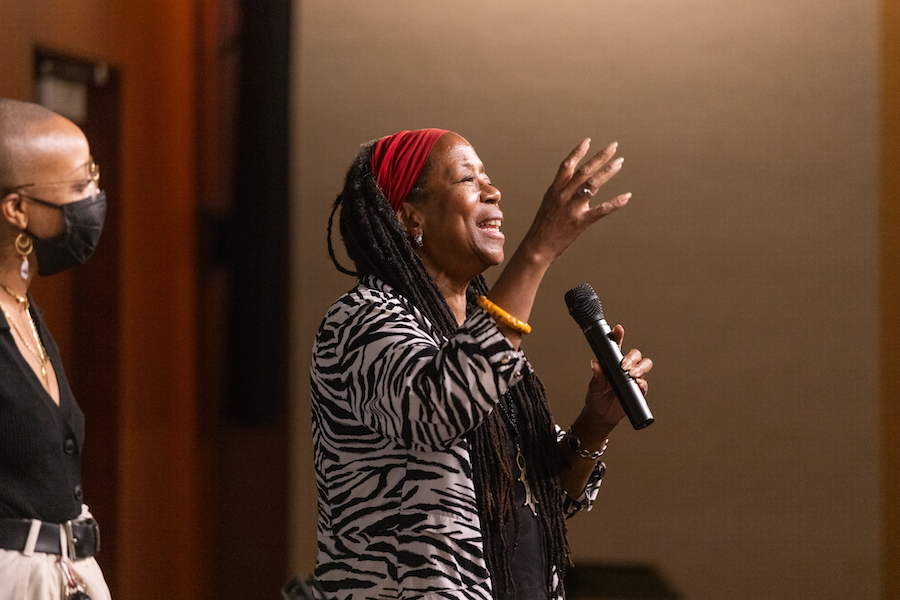
Open dialogue and inclusive community were shining elements of the first Bellarmine Forum event of the 2023-24 academic year, aptly titled “Call and Response: African Diasporic Solidarities at LMU and Beyond.” Call and response is a feature of African diasporic music where musicians voice a musical idea, and other musicians or participants respond. Its principles of musical conversation and connection with the audience can still be seen in Black music today, from jazz to R&B to rap, and even Zambian rock.
Jalylah Burrell, assistant professor of African American studies, organized the interdisciplinary, all-star panel, which featured Keisha Chin-Goosby, clinical assistant professor of teaching and learning; Bernard Brown, assistant professor of dance; Cheryl Grills, President’s Professor of psychological science; Kim Harris, assistant professor of theological studies; and Kaelyn Sabal-Wilson ’19, lecturer of African American Studies.

Before diving into the discussion, Burrell set the stage with a quote by the poet Gwendolyn Brooks, the first Black poet to win the Pulitzer Prize: “We are each other’s harvest; we are each other’s business; we are each other’s magnitude and bond.” Burrell then asked the panelists to reflect on the notion of belonging and identity in the diaspora by sharing where they feel most at home.
Grills transported the audience to Kumasi, Ghana, the capital city of the Ashanti region, West Africa’s most prominent cultural center, and a city that has greatly contributed to African Diasporic life. “It is the place where I can truly exhale and the place that continues to teach me about what it means to be African,” said Grills. She also talked about Ghana as a spiritual place, specifically the Black and White Powers Shrine led by Nora Abass. She has taken her whole family there and many Loyola Marymount University students over the past 20 years. Harris also talked about the significance of Ghana to her. “There is something about it where my body feels at home,” she said.
Brown brought the audience back to Los Angeles, specifically South Los Angeles, where he grew up. He described South L.A. as a very Black place and a very Southern place where African American culture has grown and flourished and where he found his first mentors in ancestorism. Havana, Cuba, was also a transformative place for Brown. He remembers seeing himself in the Black Cubans and feeling connected to a broader Black community.
To Chin-Goosby, home is not a city but a town square or any gathering place that brings people together. She spent her early childhood years in Jamaica. She recalled hanging out at her family’s store on the square, hearing the music, watching the adults dancing, and experiencing a multi-racial and multi-generational community for the first time.
“There are four things that make a place feel like home: a body of water, a marketplace or meeting place, a beauty supply, and Caribbean food or fish fry,” said Kaelyn Sabal-Wilson, who studied African American studies and communications at LMU and has recently returned as a lecturer in African American studies. While pursuing her M.A. in creative writing from Goldsmiths, University of London, she frequented the vibrant Brixton market. “All these things and more exist in Brixton market, and I feel free, safe, and at home there.”
Whether in Harare or Long Beach, people of African descent are shaped by educational systems and entertainment programming that have historically minimized, demeaned, or excluded Black histories and humanity. Burrell urged the panelists to discuss how widely-circulating stereotypes shaped their encounters with people from other parts of the African Diaspora. Harris mentioned the “social distance” between African immigrants and African Americans, noting that the former are told not to hang out with the latter. Chin-Goosby also touched on this dynamic, noting two commonly circulated and opposing views she encountered when her family was immigrating to the U.S.: America is the promised land, and you don’t want to be Black in America.

Grills shared how she wrestled with how she, as an African American, would be received by the Ghanaian/west African communities she held dear/visited, an idea she had the opportunity to unpack when interviewing elders from Charleston and Manning, South Carolina. She discovered cultural retentions so subtle that she didn’t register them as African until she started going to Africa. She realized that traditions like being deeply rooted in spiritual beliefs and respecting your elders matter whether one is, as she has written, “African, Black, Neither, or Both.”
Brown shared that he had to overcome a lot of myths growing up as a queer Black man in South Los Angeles , including what constitutes a complete family unit. “It took me a long time to realize that just because I came from a ‘flawed’ family does not mean I am flawed. I’m now proud of my lineage and especially my grandmother who raised me,” he said.
Underscoring the importance of genealogy in understanding one’s identity, Burrell asked the panelists how their African ancestry has contributed to their professional work. Grills talked about her ability to access and apply her spiritual intuition in working directly with students, clients, and patients. “In my clinical practice, I learned that meaningful information can come to us through our spirit or our extra sense, like spontaneously knowing something about someone or knowing about something before it happens,” she said. “Allowing my intuitions to come into play has enriched my ability to connect with people as a psychologist and professor.”
Brown discussed his training in the Katherine Dunham technique, which combines individualistic dance movements of Caribbean and African cultures with European-style ballet. “In contemporary dance, we learn how to articulate and liberate the spine. If your body can be free, your mind can be free,” he said. “If I can get free in this Black body, what else is out there for me to grab onto?”
Harris led the audience in singing a hymn in the call and response form and recognizing the power, hope, and community that music provides; Burrell concluded the event by asking each panelist to share a song they hold close to their heart. These have all been compiled into a playlist to enjoy and draw strength from.




